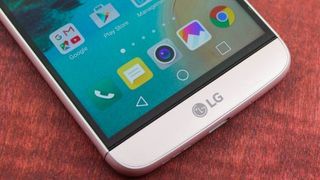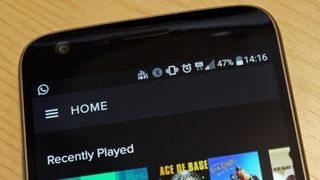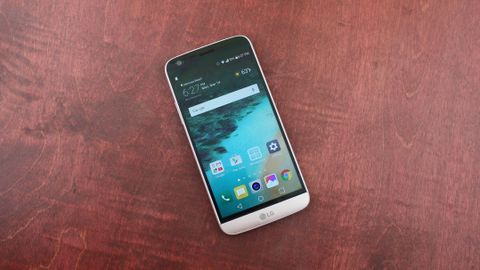Why you can trust TechRadar
Display
The LG G5 doesn't try to squeeze more pixels into its 5.3-inch display, and that's something I'm actually happy to see. QHD resolutions (1440 x 2560) on phones are the ceiling that no one needs to break.
Lighting up the phone screen reveals there's little difference here. The smaller size increases the pixels per inch on the LG G5 to about 554ppi, but everything else looks similar, including the brightness.
It's not as vibrant as Samsung's Super AMOLED technology, but colors are still strong and the brightness is pleasing, allowing for an excellent viewing experience.
LG has instead, upgraded its IPS LCD to include always-on display functionality, something you won't see until the phone is asleep.

It keeps most of the screen dark, but leaves minimal information there, like the time, date and notification icons.
The Galaxy S7 and Galaxy S7 Edge tout a similar feature using Super AMOLED displays, but Samsung's always-on information bigger, brighter and can include the battery life and a faded color background.
Having used the new Samsung handsets extensively, I found the lack of a battery icon on the G5 frustrating, and at times I struggled to read the screen because the always-on display is just that dim.
However the G5 does have one major advantage over Samsung - notifications. While the S7 duo can only show icons for missed calls and text messages, the LG G5's always-on display will show you ALL your notification icons.

That instantly makes it much more useful, allowing you to decide whether it's worth firing up the power hungry full display, or to leave that WhatsApp chat for later.
All of this is useful because, when not wearing a smartwatch, I check my phone at least 100 times a day for the time and various notifications. LG says people do this closer to 150 times a day.
Whatever your number is, an always-on display puts the essentials at your fingerprints without you having to wake the phone and its power-hungry processor.

The Moto X Style display does something similar, but the LG G5 pulls it off without the need for hand-waving gestures to trigger a bunch of IR sensors. It's the true meaning of always-on.
LG says the battery only drains an extra 0.8% an hour with its new second screen, and that seems like a great trade off at first blush.
But that adds up to be 19.2% over a full 24 hours. It may not be worth keeping this feature if you don't have a smartphone-glancing obsession.
LG Friends
The LG G5 is not alone. In fact it launched with an entire posse, dubbed 'LG Friends'.
These 'Friends' are a range of accessories that are tasked with taking the phone to the next level. I like the ideas of each, but in practice they're unconvincing.
There are just two modules available that you can physically plug into the LG G5, Cam Plus and Hi-Fi Plus - and while LG promised more in the coming months after launch, we've seen new options dry up completely as the modular design failed to catch on.

There are more accessories too, which aren't a modular bolt-on for the G5. The LG 360 VR headset and 360 Camera allow you to record and then watch 360 videos, while LG's cute Rolling Bot is a fun toy-come-home security camera.
These 'Friends' can be controlled via the LG Friends app which comes preinstalled on the LG G5.
LG Cam Plus
The LG Cam Plus replaces the G5's metal chin with a rubberized camera grip that juts out at the back. It has a physical shutter button, dedicated record key, a zoom wheel and a 1,200mAh battery.
Turn the G5 to landscape ready to snap a photo and the Cam Plus grip immediately comes into its own, allowing you to get hold of your phone properly and quickly snap away without the fear of dropping it.

Finish snapping though and things get much more awkward. Because the Cam Plus bulks out at the bottom, it's tricky to hold and makes typing and just general usage rather annoying. The saving grace is the power pack, which helps the G5 last a full day - but I'd rather carry a charging cable.
It was satisfying to set autofocus by half shutter key, but it's not really enough to make me want run out and upgrade my LG G5 with a strange camera grip bump - although with its price slashed to just $20 (£35.99, around AU$30) it's far more appealing than it was at launch where it was almost four times (double in the UK) the price.
LG Hi-Fi Plus
The same can be said about the Hi-Fi Plus. It's a portable Hi-Fi digital-to-audio converter that's small, but still extends the size of the phone by replacing the metal chin while setting you back around $85 (£144, AU$115). You can get an entry level smartphone for the same price.
It may add a little bit of extra length to the G5, but it's far less intrusive than the Hi-Fi Plus, and the phone still sits nicely in the hand and slides into a pocket without issue.

Tuned by Bang & Olufsen, LG has cornered the market on 32-bit Hi-Fi DAC in the mobile world. It did a nice job of this on the LG V10, but its bigger phablet had the perk built-in, not as an accessory.
The module has its own headphone input, which means that if you're using the Hi-Fi Plus your G5 will sport two headphone jacks - one at the top and one at the bottom. It's not a huge issue, but feels like a slight misjudgment from LG.

Plugging in and the sound is very good, but playback from the stock headphone jack wasn't exactly poor. A small icon appears in the notification bar during playback, highlighting your enhanced audio credentials.
I switched between the two ports numerous times to gauge the difference, and while Hi-Fi Plus does provide the better experience, I wouldn't say the gulf between the two is all that big.
The more discerning audiophiles among you may well be able to appreciate the work Hi-Fi Plus is doing, but for someone like myself I can't say it's worth spending the extra money on.
Current page: Display and modular capabilities
Prev Page Introduction and design Next Page Specs and performance

